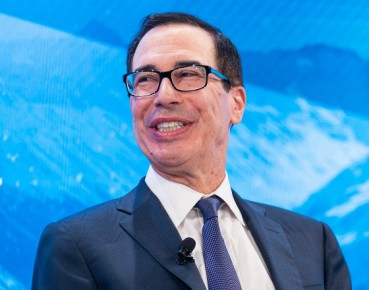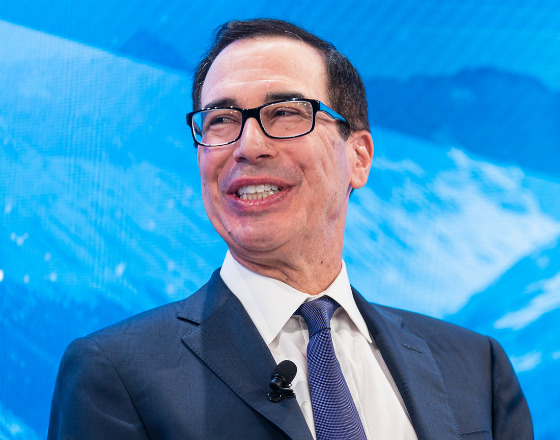
Steven Mnuchin (©WEF/Manuel Lopez, CC BY-NC-SA)
“If people want arbitrarily to put taxes on our digital companies, we’ll consider arbitrarily putting taxes on car companies,” this statement of the US Secretary of the Treasury delivered during one of the panels during the World Economic Forum in Davos, Switzerland, received wide publicity. Last year, a 3 per cent tax on revenues of companies operating online (such as Facebook and Google) was introduced in France. At that time the US responded by imposing tariffs, and now it is threatening not only France, but potentially the entire European automotive industry. During bilateral meetings the Americans were trying to convince their European partners to abandon the digital tax. It seems that the EU countries will not leave the matter on a knife edge, so a new front of trade war may not open, but it remains to be seen.
Indo-Pacific and Indonesia
Apart from the current politics, the most interesting debates were related to Asia. The expression Indo-Pacific was intertwined therein. It is a term that was used by the Japanese Prime Minister Shinzo Abe in 2007. The issue raised then was that Japan and India treated the Indian Ocean and a part of the Pacific as a common strategic and economic space. Today, the Indo-Pacific rather means that the US perceives Japan, India and Australia as a counterbalance to the confrontation with China.
At the same time, it was emphasized that this is the Asian century since in terms of GDP this continent is bigger than the rest of the world combined. Wei Sun Christianson from Morgan Stanley divided local economies into three groups. The first group comprises Japan, New Zealand and South Korea. These are developed economies: with high income per capita, capital, technology and high consumption. The second group contains emerging markets and China should be included here. However, China is shifting from the model based on labor-intensive production for global needs in which Indonesia, Thailand and Vietnam took the lead. A third group of countries includes, for example, India, Bangladesh, Sri Lanka and Pakistan — less involved in the globalization, however, with the potential to find a place in the service sector.
“Technology will change many relationships around the world. India is already the third largest venture capital ecosystem with over 9,000 VC companies. Indonesia is the leader of ASEAN (Association of South-East Asian Nations). We have the most positive attitude towards Indonesia. We take into account its demographic strength: an average age of 28 years and a lower financial sector debt. This is a great opportunity for growth,” Wei Sun Christianson said.
Japanese social crisis
Growth has not been seen in Japan for a long time and not everything can be explained by poor demography. The issue is a little more complicated since the entire panel in Davos was devoted to Japanese society. Hiromi Ozaki, an artist and academic teacher from Tokyo, said that poor fertility rate in Japan could also have resulted from the closure of Japanese corporations to young people and women. She added that she is also concerned about the fact that Japanese students are less and less frequently willing to study abroad and less and less interested in the world.
Julie Bishop, Australia’s former Minister for Foreign Affairs, argued that this approach will have to change by 2030, when more than 30 per cent of Japanese society will be over 65 years old and growing health care costs will force the admission of immigrants. However, she earlier stressed that she was saying that from the perspective of Australia, i.e. a country that was created as a result of immigration processes.
There are no safe assets
Demography plays a huge role, however, not only in Japan but also in other developed economies. One of them is an increase of savings which drives the demand for safe assets, rising their prices. As a result, debt bearing negative interest debt has already exceeded USD17 trillion (at least for a while last year). The Davos panel entitled “There are no safe assets?” focused on this issue.
“In fact, safe assets do not exist. Banks need to find assets that provide a different kind of risk and diversify them also through portfolios with multiple assets,” Anne Richards, the Fidelity International CEO said.
The world of negative rates also has consequences, not only for commercial banks and insurance companies but also for central banks. Professor Kenneth Rogoff, Harvard University, said that “the problem we are talking about would not be different if inflation reached 8 per cent and the interest rate 6 per cent, and anyone who wanted to retire would observe how their savings were melting (…) We, the economists, believe that monetary policy can only have a slight impact on the timing of this phenomenon, however, this is not the fundamental reason for where the interest rate is placed in relation to the inflation rate. These fundamental reasons include savings, investment, demography,” he listed.
“My simple point of view is that once interest rates have been brought to zero, including long-term rates, and if you do not want to go into negative rates, everything else you can do smells like fiscal policy. If central banks buy assets, it is fiscal policy, even if it is called monetary,” noted Paco Ybarra CEO of Citi Institutional Clients Group.


